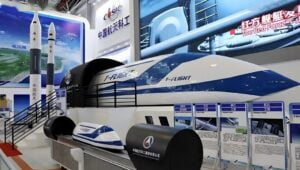ButSpeak.com
News which Matters.

China’s maglev hyperloop project undergoes a successful test, advancing toward its goal of achieving speeds up to 1,000 km/h. The futuristic transport system aims to revolutionize travel between mega cities.
China has taken a significant step forward in its ambitious maglev hyperloop project, successfully completing a test run that is part of an effort to develop a train capable of reaching speeds up to 1,000 kilometers per hour (621 miles per hour). The test was conducted in a 2-kilometer-long low-vacuum tube located in Datong, Shanxi province, marking the first time the full integration of the train’s systems has been put to the test.
Although the project developer did not disclose the exact speed achieved during this trial, they reported that the results met their expectations. According to the official Science and Technology Daily, the superconducting maglev vehicle demonstrated controlled navigation, stable suspension, and safe stopping. The track closely matched the theoretical trajectory, indicating a successful test of key technologies, including superconducting navigation control and system coordination within the low-vacuum environment.
“This test improved the overall technical maturity of the system and laid a solid technical foundation for the next test,” a representative of the project said, underscoring the importance of this milestone in the project’s development.
Known as the “high-speed flying train,” this hyperloop project is a collaborative effort between the Shanxi provincial government and the state-owned China Aerospace Science and Industry Corporation. Engineers involved in the project are optimistic that the maglev trains will eventually achieve plane-like speeds, effectively “flying on the ground.”
Construction of the full-scale test line in Datong, which integrates aerospace and railway technologies, began in April 2022 and was completed by November 2023. The developers claimed that a previous hyperloop test had set a new speed record, surpassing the former benchmark of 623 km/h, though they did not disclose the exact speed achieved.
The potential applications of this technology are vast, with official reports suggesting that the ultra-high-speed trains could one day link some of China’s mega cities. This could reduce travel times significantly, such as cutting the journey from Beijing to Shanghai—a distance of over 1,200 kilometers, which currently takes more than four hours by bullet train—to just 90 minutes.
The concept of a hyperloop—a transport system within a low-pressure tube—first emerged over a century ago but gained renewed interest after tech billionaire Elon Musk outlined his vision for the technology in a 2013 white paper. The hyperloop aims to address the main challenges of railway transport: friction between wheels and track, and air resistance against the train body. By using magnetic levitation (maglev) to eliminate friction and operating within a low-vacuum tube to reduce air resistance and noise, the hyperloop promises unprecedented speeds for ground transportation.
While the technology has not yet become a reality, and despite setbacks such as the closure of Musk’s Hyperloop One in 2023, China’s continued progress in developing its maglev hyperloop represents a significant stride toward realizing this futuristic vision. The journey ahead is challenging, but the potential impact of this technology on global transportation is immense, promising to revolutionize how we travel between cities.